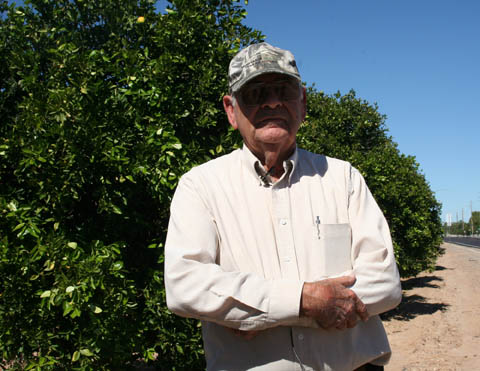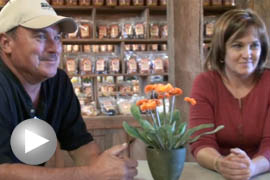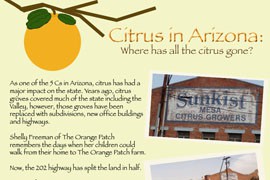Arizona’s Five Cs: Citrus

Arizona citrus farmers face a host of challenges with changing economy
Don Shaw, owner of Verde Oro Farms, has grown citrus orchards in Arizona for nearly five decades. But citrus farming isn’t was it used to be, he says. Photo by Victoria Pelham
By Victoria Pelham
MESA – Don Shaw, owner of Verde Oro Farms, has been farming citrus orchards in the East Valley since the 1960s, persevering even as development led to the sale and closure of many groves.
It hasn’t been easy to continue.
Arizona citrus producers face rising competition from other states and abroad as well as increasing costs for essentials such as fuel and pesticides.
These days, those who want to get out of the business often are unable to sell their land as development has slowed, he said.
“It’s getting to be a real … problem farming in this city,” Shaw said.
Here and elsewhere around Arizona, fewer farmers make a living off citrus, one of the historic Five Cs of the state’s economy along with cotton, cattle, copper and climate.
Arizona’s crop has changed as well, with lemons now by far the leading citrus fruit, while production of oranges and grapefruit has dropped to the point that the U.S. Department of Agriculture no longer includes those in its accounting of the state’s totals.
During the 1977-1978 growing season, there were 52,640 acres of citrus-bearing land in Arizona, according to the USDA’s National Agricultural Statistics Service. In 2008-2009, the last season the service included oranges and grapefruit in its totals for Arizona, that number had fallen to 17,300.
For 2010-2011, the service reported 13,500 citrus-bearing acres in Arizona.
Arizona’s citrus market is stabilizing after losing acreage, said John Caravetta, associate director of the state Department of Agriculture, pointing to slight gains in the value of citrus production in recent years.
That value rose to $38 million in 2010-2011 from $37 million in 2009-2010 and $36 million in 2008-2009.
Still, the citrus industry in Arizona remains under threat, Caravetta said.
Orchards here face an increased risk from pests, most notably the Asian citrus psyllid, an invasive insect that has decimated groves in Florida by spreading a disease called citrus greening. A few of the insects have found in Yuma and one was discovered recently in Nogales, but the species isn’t established in Arizona.
Arizona citrus farmers also face growing competition from countries such as Brazil and Australia, as well as from states such as California.
“Those are all threats to a fragile industry, if you will, but one that certainly has the potential to be a continuing part of Arizona’s agricultural landscape,” Caravetta said.
Caravetta said the future of the industry in the Phoenix area is somewhat uncertain. The last packing plant in Mesa closed in 2010 because there wasn’t enough citrus remaining to support it.
Glenn Wright, a professor and citrus specialist at the University of Arizona’s Yuma Agricultural Center, said there might still be hope for citrus farming in the Phoenix area because of a national trend toward locally grown produce.
“There’s the potential for pick-your-own operations,” he said.
In the 1930s, the Valley’s citrus production centered around grapefruit but switched over the years to oranges. Shaw harvests mostly navel and Valencia oranges from his Mesa orchards, for example. But the industry has begun turning toward lemons and tangerines, which provide greater returns, Caravetta said.
Since the Valley’s packing plant closed, citrus farmers here have had to ship to packing plants in Yuma, where the majority of Arizona’s commercial citrus acreage is located, Caravetta said.
Wright said the citrus industry is declining in Yuma as well, but at a slower pace. This is partly due to development but also because some farmers are moving to other crops such as dates and olives.
As for the future of citrus in the Valley, Shaw doesn’t see one.
“It’s just a matter of time until it’s gone,” he said.










